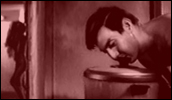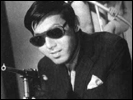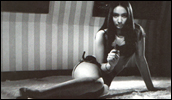Branded to Kill
- Year
- 1967
- Original title
- Koroshi no Rakuin
- Japanese title
- 殺しの烙印
- Director
- Cast
- Running time
- 91 minutes
- Published
- 20 March 2001



by Jasper Sharp
Born in Tokyo in 1923, Seijun Suzuki directed 42 films for Nikkatsu, averaging about four a year, and he claims he could edit each in about a day. Despite being lauded by the critics for his unique visual style, as far as the general public and Nikkatsu president Kyusaku Hori were concerned by the mid-60s Suzuki's approach was beginning to spin rapidly out of control.
In the latter part of the 60s, Nikkatsu's undemanding youth-oriented potboilers were beginning to lose the company serious money. A scapegoat was needed, so after the colourful excesses of Tokyo Drifter (Tokyo Nagaremono, 1966) Suzuki was told to turn in something a little more conventional or else. Branded to Kill was the result and it was sufficiently whacked out for Nikkatsu to give him his marching orders ("They told me my films didn't make money and they didn't make sense, so they fired me", Suzuki opines in the interview accompanying this DVD release.)
The story concerns Hanada, or Number 3 Killer, played by the hamster-faced Jo Shishido (who famously had collagen implants in his cheeks to enhance his box-office appeal), a terse yakuza assassin in shades who is turned on by the smell of boiling rice. Approached by the beautiful but deadly Misako (Mari Annu) to undertake a 'kill or be killed' contract, he soon finds himself entranced by this mysterious femme fatale with a bedroom full of entomological specimens and an impaled starling dangling from the rear view mirror of her car. When he botches up the job due to an untimely butterfly landing on his gun-sites, his own girlfriend is secretly hired by the mob boss to kill him. From then on it's bullet-riddled mayhem all the way until a head-to-head finale set in a deserted boxing gymnasium with the anonymous Number 1.
With its grounding in a sumptuous pop art aesthetic, the laid-back and jazzy musical counterpoint, the stunning monochrome scope cinematography and masterful use of light and shadow, Branded Kill is pretty hard to resist. However, to be honest it isn't the most accessible of films and for those unfamiliar with Suzuki's unorthodox and seemingly disjointed style it will probably take a couple of viewings before the bare bones of the plot begin to emerge. Suzuki's credo that editing is merely the manipulation of space and time makes for some strikingly staged action sequences (one of them later lifted and paraphrased in Jim Jarmusch's Ghost Dog: The Way of the Samurai), though does have a tendency to obscure some of the finer details of the narrative.
Still, Branded To Kill's appeal hardly rests in its plotting, so whilst decidedly unconventional in terms of exposition and characterisation, the story is best viewed as little more than a backbone for the director to weave his magic. It is the impromptu breaks from script formula, the bizarre mish-mash of styles, and the inventive re-framing of conventional shots (according to Suzuki shots were more or less improvised during shooting due to logistical reasons such as time and budget) that are always the most refreshing aspects of a Suzuki movie. Put quite simply, Branded to Kill is a bloody marvellous looking film and arguably the pinnacle of the director's strikingly eclectic style.
After his dismissal Suzuki successfully sued Nikkatsu. However, the fracas was enough to muddy his reputation and kept him out of work until he returned with Story of Sorrow and Sadness (Hishu Monogatari, 1977), detailing the highs and lows of a professional female golfer. He truly found his feet again with 1980's Zigeunerweisen and successfully resurrected his career, carrying it on into the 90s with Yumeji (1991). In 2001 Suzuki delivered a belated sequel to Branded To Kill, without Jo Shishido, entitled Pistol Opera.